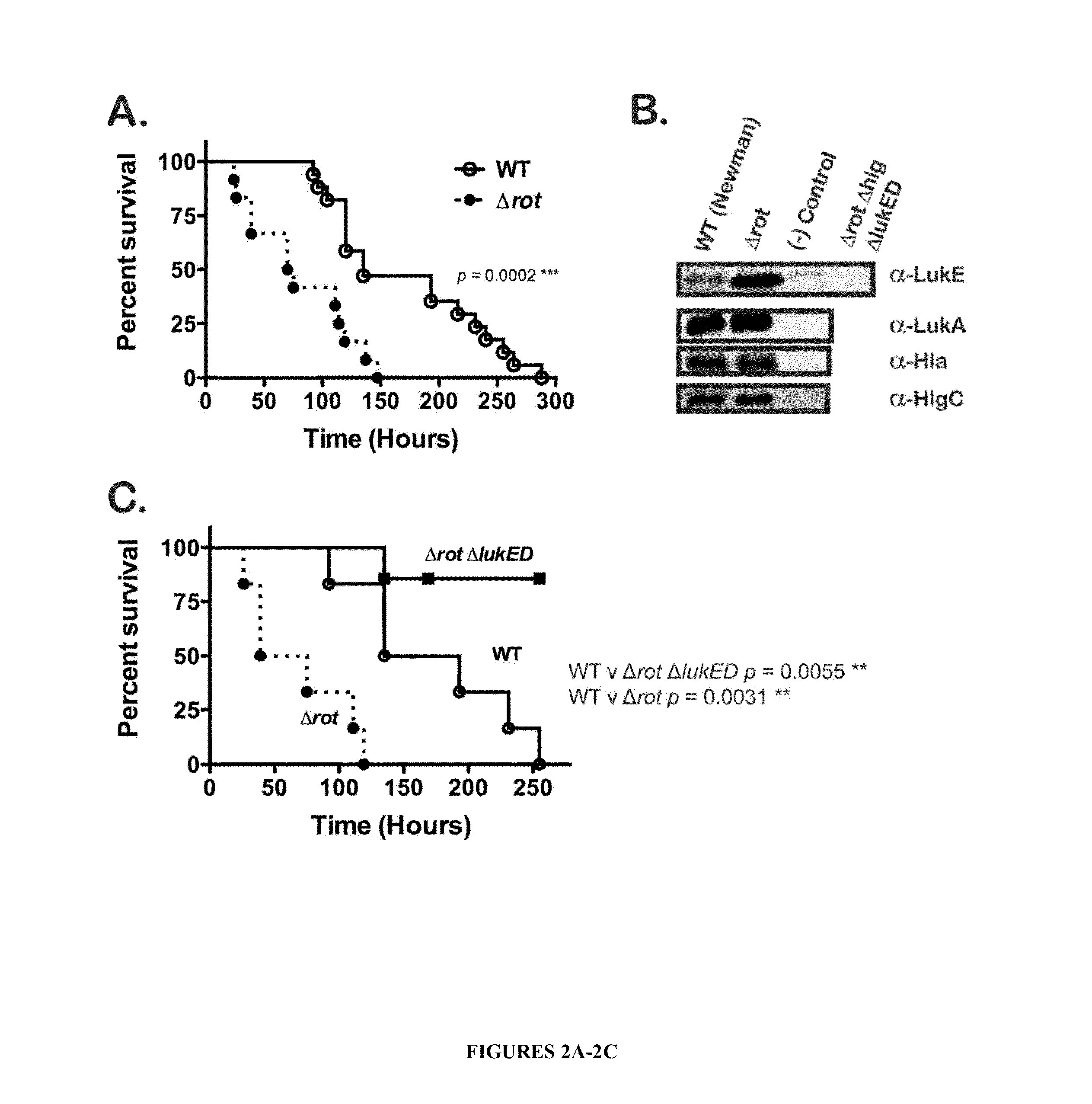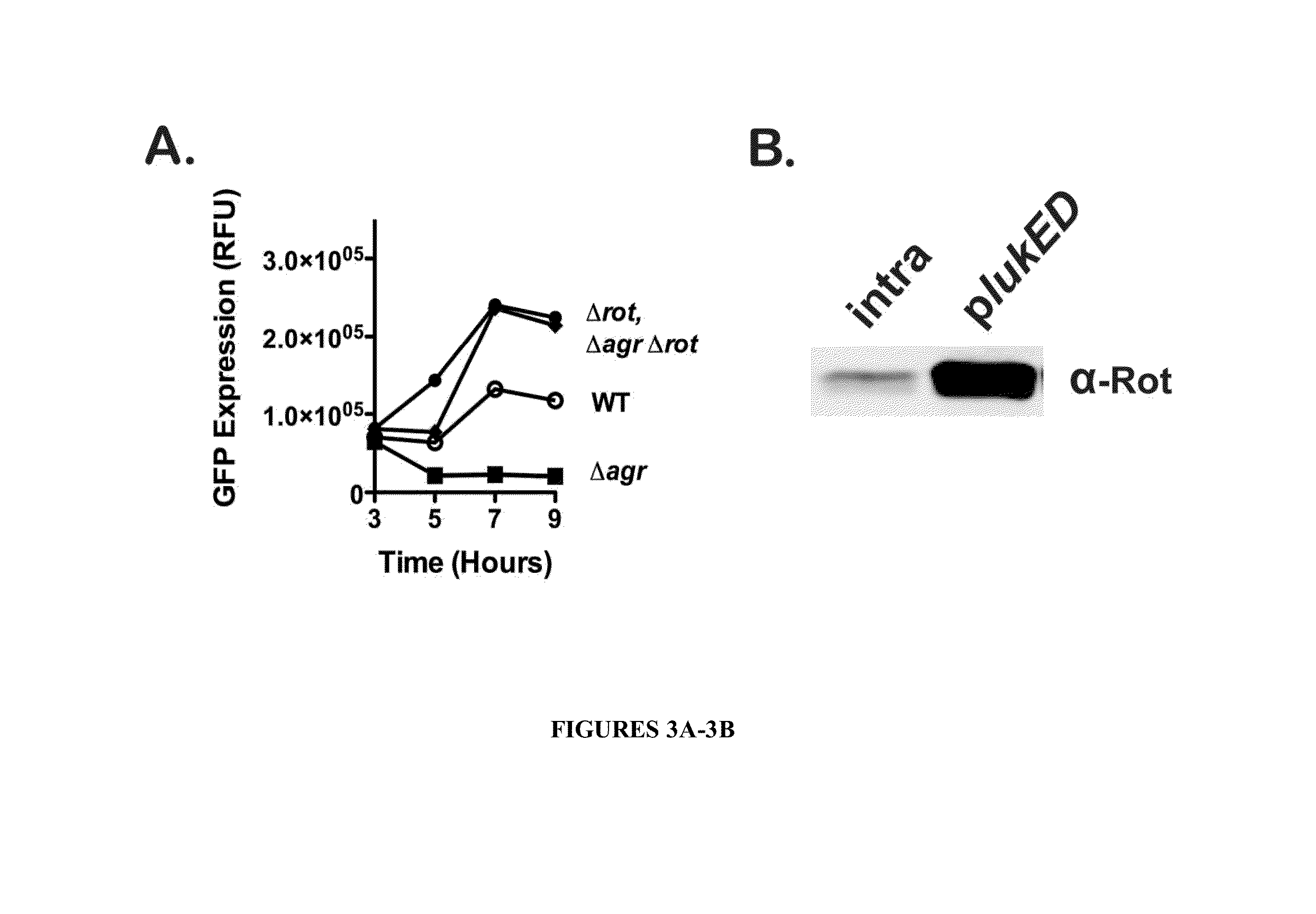Methods of treating and preventing staphylococcus aureus infections and associated conditions
a staphylococcus aureus and associated disease technology, applied in the direction of antibacterial agents, antibody medical ingredients, peptide/protein ingredients, etc., can solve the problems of bacterial dissemination and disease, and the difficulty of designing effective therapy for treating mrsa infection
- Summary
- Abstract
- Description
- Claims
- Application Information
AI Technical Summary
Benefits of technology
Problems solved by technology
Method used
Image
Examples
example 1
Inactivation of Rot Enhances the Virulence of a S. Aureus Strain Lacking agr
[0104]In recent studies it has been found that S. aureus mutant strains that lack both the master regulator known as the accessory gene regulator (“Agr”) and the transcription factor repressor of toxins (“Rot”) (i.e., Δag Δrrot) exhibit enhanced virulence in a murine model of systemic infection compared to the highly attenuated Δagr mutant. While a Δagr single deletion mutant is highly attenuated for virulence as measured by survival over time post-infection, an Δagr Δrot double mutant displays virulence characteristics similar to that of the parent strain (WT Newman) (FIG. 1A). It was speculated that the increased virulence observed in an Δagr Δrot double mutant might be due to enhanced expression of S. aureus leukotoxins as many of these toxins are believed to be regulated in an Agr-Rot dependent manner. Indeed, immunoblot analysis of the toxins produced by S. aureus Wild Type, Δagr, and the Δagr Δrot muta...
example 2
LukE / D Contributes to the Enhanced Virulence Exhibited by a S. Aureus Strain Lacking Rot
[0105]The results described in FIGS. 1A-1B indicated that inactivation of rot in an agr+ strain might also result in increased virulence, possibly in a LukE / D dependent manner. As with the Δagr Δrot double mutant (FIG. 1A), it was observed that a Δrot single deletion mutant also resulted in enhanced virulence in a murine model of systemic infection, as evidenced by the decrease in percent survival of animals infected with Δrot compared to those infected with WT (FIG. 2A). Earlier observations demonstrated that Rot is likely a major repressor of the leukotoxin LukE / D. To confirm these findings in the context of the single Δrot deletion mutant, immunoblot were performed. These experiments revealed that indeed LukE / D is highly produced in the absence of rot, contrary to LukAB, γ-hemolysin (HlgC), or α-toxin (Hla; FIG. 2B). These findings further strengthened the supposition that LukE / D is the major ...
example 3
Rot Represses LukE / D Expression by Directly Binding to the LukE / D Promoter
[0106]To further examine the influence of Rot on lukE / D gene expression, transcriptional fusions of the lukE / D promoter region to a gene that encodes for the green fluorescent protein (GFP) were constructed and fluorescence was measured over time in broth culture using WT, Δagr, Δrot, and Δagr Δrot strains. As suspected, gene expression of lukE / D was increased over that of WT in strains lacking Rot, while strains expressing large amounts of Rot (Δagr mutants display increased Rot levels) were decreased in expression. To assess whether repression of lukE / D by Rot is direct, the ability of Rot to bind to the lukE / D promoter was examined using a promoter pull-down strategy. Bacterial whole cell lysates were incubated with lukE / D promoter DNA or nonspecific intergenic DNA bound to magnetic beads. Immunoblot of bound proteins demonstrated that Rot indeed binds to the lukE / D promoter in a specific manner (FIG. 3B). ...
PUM
| Property | Measurement | Unit |
|---|---|---|
| Composition | aaaaa | aaaaa |
| Electrical resistance | aaaaa | aaaaa |
| Immunogenicity | aaaaa | aaaaa |
Abstract
Description
Claims
Application Information
 Login to View More
Login to View More - R&D
- Intellectual Property
- Life Sciences
- Materials
- Tech Scout
- Unparalleled Data Quality
- Higher Quality Content
- 60% Fewer Hallucinations
Browse by: Latest US Patents, China's latest patents, Technical Efficacy Thesaurus, Application Domain, Technology Topic, Popular Technical Reports.
© 2025 PatSnap. All rights reserved.Legal|Privacy policy|Modern Slavery Act Transparency Statement|Sitemap|About US| Contact US: help@patsnap.com



